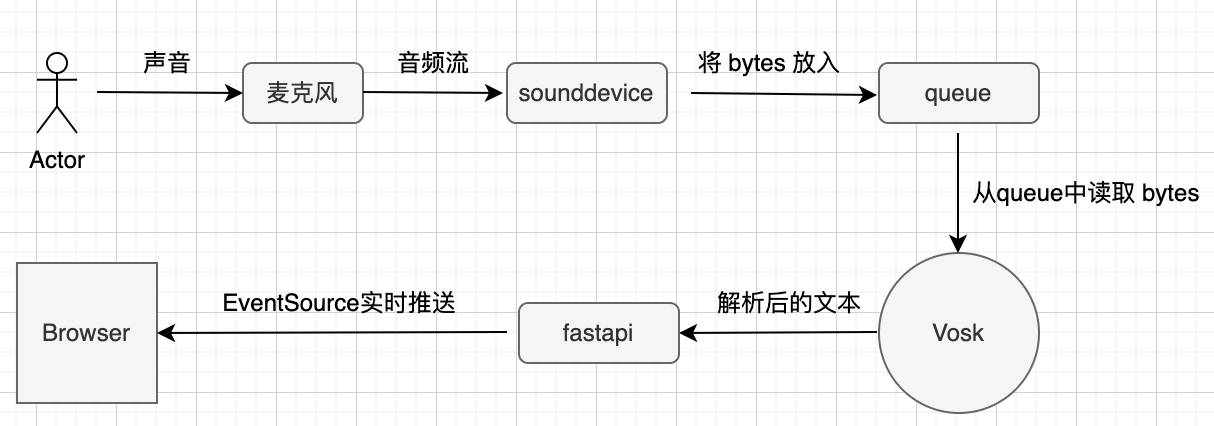用Vosk实现实时语音识别
阅读 5.9k
实时语音识别是将音频流实时识别成文字,在视频直播、会议和课堂等场景都能派上用场。本文介绍如何使用开源库Vosk来在边缘设备上实现实时语音识别。
为什么是Vosk
Vosk库是一个开源的语音识别库,它基于Kaldi语音识别框架,并专为在边缘设备上运行而设计。与大型云服务提供商(阿里云、腾讯云等)的语音识别服务相比,其准确率会差不少。但是,它是开源的,可以免费使用,这对于预算有限的项目来说还是不错的。同时,Vosk可以在隐私敏感或网络不可靠的环境中部署。很适合性能受限的边缘设备上使用。它既支持录音文件识别,也支持实时语音识别。
技术实现
Vosk提供了多种语言的API,包括Python、Java、C++等,可以方便地集成到各种应用程序中。因为Python具有灵活、简单的特点,很适合中小型项目的业务场景,这里就以Python语言来实现该功能。同时,为了便于实时查看,还需要将识别出来的文本实时推送到网页上进行展示。
我们来看下需求的流程图,如下所示:

首先,sounddevice模块将麦克风中的音频流处理为 bytes 放入到队列中,Vosk 从队列中读取 bytes 进行识别,得到解析后的文本。最后,解析后的文本使用 fastapi 和 EventSource 实时推送到浏览器中进行展示。核心代码如下:
import asyncio
import json
import queue
import sounddevice as sd
import vosk
from fastapi import FastAPI
from fastapi.middleware.cors import CORSMiddleware
from fastapi.responses import StreamingResponse
app = FastAPI()
# 配置 CORS
origins = [
"http://0.0.0.0:5500",
"http://localhost:5500",
"https://your-other-domain.com",
"*", # 允许所有域名,慎用
]
app.add_middleware(
CORSMiddleware,
allow_origins=origins,
allow_credentials=True,
allow_methods=["*"],
allow_headers=["*"],
)
# Vosk 模型和音频队列
q = queue.Queue()
model_path = "models/vosk-model-cn-0.22"
device_index = 0 # 替换为你实际的设备索引
model = vosk.Model(model_path)
# SSE 生成器
async def event_generator():
recognizer = vosk.KaldiRecognizer(model, 44100)
while True:
try:
data = q.get()
if recognizer.AcceptWaveform(data):
result = recognizer.Result()
else:
result = recognizer.PartialResult()
json_str = json.dumps(
json.loads(result), separators=(",", ":"), ensure_ascii=False
)
yield f"data: {json_str}\n\n"
await asyncio.sleep(0.1) # 控制发送频率
except Exception as e:
yield f"data: error: {str(e)}\n\n"
# SSE 路由
@app.get("/stream")
async def stream():
return StreamingResponse(event_generator(), media_type="text/event-stream")
# 音频录制回调
def callback(indata, frames, time, status):
if status:
print(status)
q.put(bytes(indata))
# 启动音频流
async def start_audio_stream():
with sd.RawInputStream(
samplerate=44100,
blocksize=16000,
device=device_index,
dtype="int16",
channels=1,
callback=callback,
):
print("Audio stream started")
while True:
await asyncio.sleep(1)
# 在 FastAPI 应用启动时启动音频流
@app.on_event("startup")
async def startup_event():
asyncio.create_task(start_audio_stream())将上面代码复制到 realtime.py 文件中,然后用如下命令来启动:
uvicorn realtime:app --host 0.0.0.0 --port 9000 --reload成功后,在本地9000端口便启动了 fastapi 服务。如果前端需要实时展示,可以创建一个 index.html 文件,核心的JavaScript代码如下:
let eventSource = ''
new Vue({
el: '#app',
data: {
rows: []
},
methods: {
startRecognize: function () {
eventSource = new EventSource('http://0.0.0.0:9000/stream')
eventSource.onmessage = event => {
let currRowIndex = this.rows.length - 1
const data = event.data
const { partial, text } = JSON.parse(data)
console.log(currRowIndex, data, partial, text)
// partial 有数据,更新当前行的row内容
if (partial !== undefined) {
this.rows[currRowIndex] = partial
}
// text 出现,该句结束
if (text !== undefined) {
console.warn('new line...')
if (text !== '') {
this.rows[currRowIndex] = text
this.rows = [...this.rows, ''] // 在原有行的基础上,增加一行,值为 ""
}
}
}
eventSource.onerror = function () {
console.error('SSE 连接出错')
eventSource.close()
}
}
},
mounted() {
this.rows = ['']
this.startRecognize()
}
})这里使用Vue2,前端页面通过URL地址 http://0.0.0.0:9000/stream 来订阅 eventsource 服务。
注意事项
在实现的过程中,有几个坑要注意:
- evensource返回的格式。eventsource必须要以
data:开头,以\n\n结尾,中间不能出现单个的\n。 - 传递给sounddevice的设备id要正确,可以通过
sd.query_devices()来获得正确的麦克风id。
最后编辑于: 2024-12-22